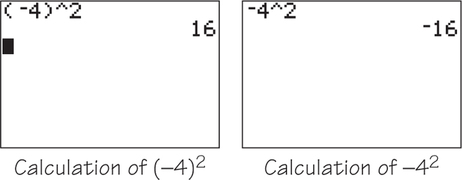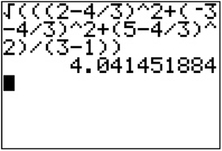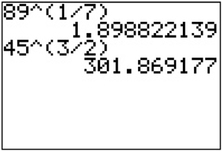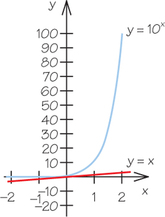Algebra Review VI: Exponents, Roots, and Logarithms
A. Powers and Roots
Powers
A positive integer exponent or power is a convenient shorthand for indicating repeated multiplication of a number a called the base. For example, the expression a2, read as “a squared,” means a multiplied by a. When either a positive or negative number is squared, the outcome will always be positive. When 0 is squared, the outcome is 0.
Example 1. Simplify (−8)2.
(−8)2=(−8)(−8)=64
The expression a3 is read as “a cubed” and an is read as “a to the nth power,” or simply “a to the n.” For positive integer powers of n, it means that a is multiplied times itself n times.
an=a⋅a⋅a⋯a︸ntimes
Example 2. Simplify 25,(−2)3, and (−3)4.
25=(2)(2)(2)(2)(2)=32(−2)3=(−2)(−2)(−2)=−8(−3)4=(−3)(−3)(−3)(−3)=81
Notice that when a negative number is raised to an odd power, the result is negative, but when a negative number is raised to an even power, the result is positive.
Calculator Note: When raising negative numbers to powers, always be sure to enclose the negative number in parentheses before hitting the power key.
Example 3. Use a calculator to determine the square of −4.
On a TI-84, use the keystrokes ((−)4)^2ENTER. (Other calculators should be similar.) The result is (−4)2=16 (see the calculator screenshot below on the left).

Example 4. Repeat Example 3, but don’t enclose −4 in parentheses.
On a TI-84, use the keystrokes (−)4^2ENTER, which gives the result −42=−16 (see the calculator screenshot above on the right). In this case (based on order of operations), 4 was squared first, resulting in 16, and then its opposite was taken, resulting in a final answer of −16.
Roots
The expression √a indicates a number that we square to get a. The expression √a is called the “principal square root of a,” and the outcome is never negative. The expression Va, read as the “n√anth root of a,” is the number that we raise to the nth power to get a.
n√a=b means bn=a
Example 5. Determine √144 and 5√32.
√144=12 because 122=144
5√32=2 because 25=32
When a square root (or an nth root) involves operations, it may be easier to simplify some of the calculations before taking the square root (or the nth root).
Example 6. Approximate √(3.1)(2.7)5 to one decimal place.
√(3.1)(2.7)5=√8.375=√1.674≈1.3
Example 7. The standard deviation of a set of numbers (introduced in Chapter 5 on page 204) involves a square root. Find the standard deviation of 2, −3, and 5. Give a simplified exact answer and an approximation to two decimal places.
The formula for computing the standard deviation of a set of numbers is
s=√(x1−ˉx)2+(x2−ˉx)2+⋯+(xn−ˉx)2n−1
We follow the three steps from Algebra Review III, item A, Using Formulas (page AR-7).
First, assign a meaning to the numbers.
n=3 and, x1=2, x2=−3, and x3=5. From Example 1 in item A, Using Formulas, we calculated the mean of 2, −3, and 5 and found that ˉx=43.
Page AR-23Second, substitute the constants for the variables.
s=√(x1−ˉx)2+(x2−ˉx)2+(x3−ˉx)2n−1=√(2−43)2+(−3−43)2+(5−43)23−1
Third, simplify by applying order of operations.
s=√(2−43)2+(−3−43)2+(5−43)23−1=√(23)2+(−133)2+(113)22=√49+1699+12192=√29492=√29418=√493=1√3≈4.04
Calculator Note: You can find a decimal approximation for the problem in Example 7 by entering the entire expression into your calculator before pressing the ENTER. The keystrokes for using a TI-84 to calculate the standard deviation of 2, −3, and 5 are given below.
- Press 2ndx2(for√()
- ((2−4÷3)∘2+
- ((−)3−4÷3)∘2+
- (5−4÷3)∘2)÷(3−1))
- Finally, press ENTER.
After entering these keystrokes, your calculator screen should match the one below.

Warning: When entering expressions involving parentheses into a calculator, make sure every left parenthesis has a matching right parenthesis. Also, notice that some commands, such as the square root command, may automatically include a left parenthesis that you will need to pair with a right parenthesis.
Calculator Note: The TI-84 has a square root key but no nth root key. Here’s how to compute the nth root of a number a, n√a, when n≥3:
- Enter the value for n.
- Press MATH5(for x√).
- Enter the number a and press ENTER.
Practice Exercises
Evaluate the following by hand. (Feel free to check your results using a calculator.)
- (a) (−3)4
- (b) (−2)5
- (c) 43
Evaluate the following by hand. (Feel free to check your results using a calculator.)
- (a) 4√10,000
- (b) 3√0.008
- (c) √2500
- Approximate √(2.7)2+3(4.6)4 to one decimal place.
- The dataset 1, 3, 5, 7 has mean ˉx=4. Determine the standard deviation (round your answer to two decimal places).
- Use your calculator to approximate (1+0.05)6 to two decimal places.
B. natural and Fractional Exponents
We can extend the definition of exponent to 0 and negative integers as follows:
a0=1,a≠0a−n=1an,a≠0
Example 1. Determine the values of 30,2−4, and −3−2.
30=12−4=124=116−3−2=−(132)Order of operations tells us that powersare performed before multiplication.=−19Taking the opposite of a number isequivalent to multiplication by −1.
Next, we extend the definition of exponent to fractions, in other words, exponents in the form mn with m and n integers and n>0.
a1n=n√a, a≥0 if n is evenamn=n√am=(n√a)m
In defining man (with a≥0 if n is even), it doesn’t matter if you raise a to the mth power first or take the nth root of a first. You can do whichever is easier.
Example 2. Determine 3612 and 823.
3612=√36=6
823=(3√8)2=(2)2=4
or
823=3√82=3√64=4
In the computation of 83, notice that it does not matter whether we took the cube root of 8 first and then squared the result or squared 8 first and then took the cube root.
Example 3. Write the following radical expressions using exponents: 5√x and (3√x)2.
5√x=1x5(3√x2)=x23
Calculator Note: When using a calculator, it may be easier to compute a constant raised to an exponent rather than the equivalent radical expression. See Example 4.
Example 4. Convert the following radical expressions to expressions involving exponents, and then use your calculator to approximate the values to two decimal places: 7√89 and (√45)3.
7√89=8917≈1.90(√45)3=4532≈301.87
Here’s how these computations should appear on a TI-84 graphing calculator. Notice that the fractional exponents are enclosed in parentheses.

Evaluate the following by hand.
- (a) 420
- (b) 5−2
Evaluate the following by hand.
- (a) (−27)13
- (b) (−27)23
Write the following radical expressions using exponents.
- (a) 10√x
- (b) 5√x3
Convert the following radical expressions to expressions involving exponents, and then use your calculator to approximate the values to two decimal places.
- (a) √0.0026
- (b) (5√256)2
- (c) 1√40
C. Graphs of Exponential Equations
Equations of the form y=c⋅ax are called exponential equations (or exponential functions). In such equations, the independent variable, x, is an exponent. To understand the behavior of such a relation, we can sketch a graph by plotting points and then drawing a smooth curve through the plotted points.
Example 1. Determine points on the graph of y=10x, plot these points, and then draw a graph y=10x. Compare the graph of this exponential function with the graph of y=x.
We begin by determining points on the graph of y=10x.
| x | y=10x |
|---|---|
| 2 | 102=100 |
| 1 | 101=10 |
| 1/2 | 1012=√10≈3.16 |
| 0 | 100=1 |
| −1/2 | 10−12=1√10≈0.32 |
| −1 | 10−1=110=0.1 |
| −2 | 10−2=1102=1100=0.01 |
After plotting these points, we draw a smooth curve through them to obtain a graph of y=10x. Then we add a graph y=x. The graphs of these two equations appear below.

By comparing the graphs of y=10x and y=x, we can see that as the values of x increase, the y-values of the exponential equation increase faster than those of the linear equation. This will be true for exponential equations of the form y=ax, where a>1.
Practice Exercises
Without the aid of a calculator, complete the table below to get coordinates of some points on the graph of y=4x.
x −2.0 −1.5 −1.0 −0.5 0.0 0.5 1.0 1.5 2.0 y=4x Page AR-25- Sketch by hand the graph of y=4x. (Use an x-interval from −2 to 2.)
- Graph y=ex and y=2x on the same set of axes. Use an x-interval from 0 to 2. You will need a graphing calculator. [e≈2.718 and is called the natural base. On a TI-84 graphing calculator, press 2ndLN(for ex).]
D. Rules for Exponents and Roots
Rules for Exponents
When multiplying two exponential expressions with the same base, the rule is to add the exponents.
aman=am+n
The statement above is easily understood when expanding the multiplication in a problem such as the following:
23⋅24=2⋅2⋅2︸3 times⋅2⋅2⋅2⋅2︸4 times︸7 times=23+4=27
Example 1. Simplify 35⋅34 and 743⋅713.
35⋅34=35+4=39743⋅713=743+13=753
When dividing two exponential expressions with the same base, subtract the exponents.
aman=am−n,a≠0
This last statement is easily understood when simplifying a problem, such as 2523, by cancelling as follows:
- Using cancellation: 2523=2⋅2⋅2⋅2⋅22⋅2⋅2=22
- Using the rule for quotients: 2523=25−3=22
Example 2. Determine the value of 4343 and 4346 by cancellation and by using the rule for quotients.
4343=4⋅4⋅44⋅4⋅4=1 and 4343=43−3=40=14346=4⋅4⋅44⋅4⋅4⋅4⋅4⋅4=143 and 4346=43−6=4−3=143
When raising an exponential expression to a power, multiply powers.
(am)n=am×n
To see how this rule works, we expand (23)2.
(23)2=23⋅23︸2 times=2⋅2⋅2︸3 times⋅2⋅2⋅2︸3 times︸2×3=6 times=22×3=26
Example 3. Simplify (45)3 both by expanding and by using the rule for raising to powers.
Using expansion:
(45)3=45×45×45︸3 times=4⋅4⋅4⋅4⋅4︸5 times×4⋅4⋅4⋅4⋅4︸5 times×4⋅4⋅4⋅4⋅4︸5 times︸3×5=15 times=415
- Using the rule for raising to powers: (45)3=45×3=415
Warning: Don’t touch this! There is no “distributive law for exponents.” That is, in general,
(a+b)n≠an+bn
Example 4. A student wrote the following equation on a test: (x+2)2=x2+4. What is wrong with the student’s work? Correct the error.
The student tried to distribute the square power over the addition in x+2. However, there is no distributive law for exponents. Instead the student should use the distributive law to expand the square.
(x+2)2=(x+2)(x+2)Expand the square.=(x+2)(x)+(x+2)(2)Use the distributive law.=(x)(x)+(2)(x)+(x)(2)+(2)(2)Use the distributive lawa second time.=x2+4x+4Combine like terms andsimplify.
Rules for Roots
n√ab=n√a⋅n√b
n√ab=n√an√b
The rules for roots may help us calculate a root by hand, as shown in Example 5.
Example 5. Evaluate √490,000 and √0.0036 by hand.
√490,000=√49⋅100⋅100=√49⋅√100⋅√100=7⋅10⋅10=700
√0.0036=√36√10,000=√6⋅6√100⋅100=√62√100⋅√100=610⋅10=0.06
The rules of roots can sometimes be used to simplify an expression containing a radical, as shown in Example 6.
Example 6. Simplify √9x3.
√9x3=√9x2⋅x=√9x2⋅√x=3x√x
Warning: Don’t touch this! There is no rule that is the “distributive law for radicals.” That is, in general,
n√a+b≠n√a+n√b
Example 7. A student wrote the following on a test: √16+9=√16+√9=7. What is wrong with the student’s work? Show the correct calculations.
There is no rule for addition of radicals. Instead, simplify the number under che radical sign first and then take the square root: √16+9=√25=5.
Practice Exercises
In Practice Exercises 1–10, use the rules of exponents to simplify.
- 43⋅47
- 108104
- (42)5
- 632⋅6−12
- 35⋅3
- (53)−2
- 752712
- (162)4
- 33310
- 516⋅513
In Practice Exercises 11 and 12, use the rules of roots (as shown in Example 5) to evaluate the root by hand.
- √6400
- √0.0049
- A student wrote the following on a test: √64+4=√64+√4=8+2. What is wrong with the student’s work? Use your calculator to approximate the correct answer to two decimal places.
E. Logarithms
A logarithm is an exponent, which represents the power that a number must be raised to in order to get another number: log is the power that must be raised to in order to get . We read the expression as “the base- logarithm of .”
Example 1. Determine and .
because 3 must be raised to the second power in order to get 9.
because 3 must be raised to the fourth power in order to get 81.
Notice that a logarithmic equation has a corresponding exponential equation:
because
because
The subscript (or base) of the logarithmic equation is also the base of the corresponding exponential equation.
Because our number system is base 10, we often use a base-10 logarithm, which is also called a common logarithm. For common logarithms, the base is often omitted. On most calculators the key computes the base-10 logarithm of a number.
Example 2. Determine log(1000), log(10), and log(1).
- the power to which 10 must be raised in order to get 1000. Since , we find that .
The following two properties are true for logarithms when :
- , and for base 10,
- , and for base 10,
Example 3. Simplify for .
Another important base is , which is used in continuously compounding interest problems. Like the more familiar number , is an irrational number—that is, a nonrepeating, nonterminating decimal. Its value is approximately 2.718. The base-e logarithm could be written as . Mathematics, however, uses a special notation for base- logarithms, ln , and a special title, the natural logarithm.
Practice Exercises
For Practice Exercises 1–8, determine the value of the logarithm.
- log(10,000)
- ln(1)
- ln()
Simplify the expressions in Practice Exercises 9 and 10.
F. Using Logarithms to solve Equations
When an equation contains the variable of interest as an exponent, using logarithms can help solve the equation. In this section, we use the natural logarithm, the logarithm with a base of , ln . (Another approach would be to use the common logarithm, .)
Example 1. Solve .
Because , we can estimate that the value of is between 3 and 4. Although we know the value of is closer to 3, we can’t state its exact value without logarithms. By taking the natural logarithm of both sides of the equation, we can get an exact solution. Here are the steps:
Using a calculator and rounding to two decimal places, we find that the approximate power is .
In the equation , when the variables , , and are stated, can be found by direct calculation. Solving for or is also straightforward (see Practice Exercises 3 and 4 in Algebra Review III, item B, Solving for One Variable in Terms of Another, page AR-9). However, if we want to solve for the exponent , we again turn to the technique of taking the natural logarithm of both sides of the equation.
Example 2. Solve for .
Practice Exercises
In Practice Exercises 1–3, find an exact solution, and then use your calculator to determine an approximate solution to two decimal places.
- Given , where , find the exact value for . Then find an approximation to two decimal places.